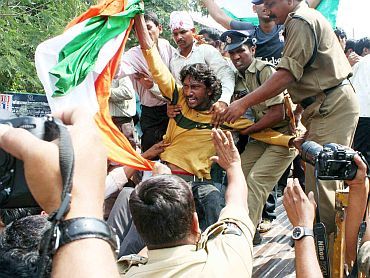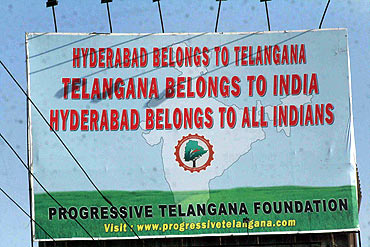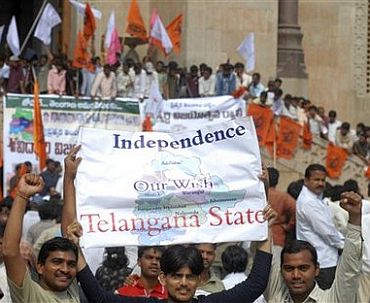 | « Back to article | Print this article |
The economics behind demand for smaller states
The Telengana movement in the state of Andhra Pradesh has picked up momentum again and is causing losses to the tune of thousands of crores (billions) of rupees to the exchequer during bandhs, not to mention the loss to the students who are actively involved in the movement.
The rationale of underdevelopment stated by the pro-Telangana activists for the formation of a separate state seems a bit stretched, especially since the socio-economic data presented in the Srikrishna Committee report and analyses by various other independent bodies do not point towards a dismal state of affairs.
The gross district level domestic product -- the most important indicator of economic growth -- has grown the fastest for the Telangana region, whether one includes or excludes Hyderabad, from 2000-01 to 2007-08.
Click NEXT to read on . . .
The economics behind demand for smaller states
The other important parameter, supply of water and electricity to the farmers, too has shown remarkable improvement over the years.
For example, the net agricultural area under irrigation, land productivity, use of electricity for agriculture and growth of electricity consumption, have all improved much faster for the Telangana region (excluding Hyderabad) than for coastal Andhra.
The expenditure on education, which is one of the most important social issues, under the Sarva Shiksha Abhiyan for the Telengana (excluding Hyderabad) and the coastal Andhra regions seems to be small and the difference can be easily reduced or taken care of with little bit of effort.
| Gross District Level Domestic Product (at 1999-2000 Prices/Rs crore) | |||
| Region | 1993-94 | 2000-01 | 2007-08 |
| Andhra Pradesh | 12235 | 16615 | 26310 |
| Telangana including Hyderabad | 11558 | 16566 | 27006 |
| Telangana excluding Hyderabad | 11391 | 15746 | 25237 |
| Hyderabad | 12745 | 22135 | 39145 |
| Rayalaseema | 12414 | 15105 | 23860 |
| Coastal Andhra | 12809 | 17301 | 26655 |
| Source: GOI, Ministry of Statistics and Program Implementation/ Sri Krishna Committee Report | |||
Click NEXT to read on . . .
The economics behind demand for smaller states
The numbers speak of the growth story of the region of Telangana. If the region was neglected, say, 20 years ago, it should not be the reason for the formation of a separate state now.
If politicians really want to help the people of Telangana, they should plan a drive to systematically get more resources from the state and central government to these regions.
Rather than asking for a separate state they should compete for resources. The MLAs from these areas should put in an effort for this.
The common man is concerned about development and knows that forming a separate state may not be the wisest of solutions to it.
Click NEXT to read on . . .
The economics behind demand for smaller states
The Centre has 10 applications for the creation of new states in India:
| Demand for | To be carved out of |
| Telengana | Andhra Pradesh |
| Mithilanchal | Bihar |
| Bhojpur | Bihar, Uttar Pradesh and Chhattisgarh |
| Saurashtra | Gujarat |
| Coorg | Karnataka |
| Vidharba | Maharashtra |
| Harit Pradesh | Uttar Pradesh |
| Bundelkhand | Uttar Pradesh and Madhya Pradesh |
| Gorkhaland | West Bengal |
| Greater Cooch Behar | West Bengal and Assam |
There are many other aspirants who have not yet filed applications, but are surely watching the developments on Telangana very closely. Bodoland (Assam), Kosal (Orissa), Ladakh (Jammu and Kashmir), Vindhya Pradesh (Madhya Pradesh), Maru Pradesh (Rajasthan) are just a few examples.
As far as economic development of these smaller aspiring regions is concerned, every state would have some developed and some not-so-developed regions. If all the not-so-developed regions start demanding a separate state, there will be no end to the number of states that we might end up having.
Click NEXT to read on . . .
The economics behind demand for smaller states
While a few of these demands may be genuine, many of these cases seem to be driven entirely because of political motivations and aspirations.
The Centre needs to take a strong stand and focus on the facts and figures related to the socio-economic growth in the region rather than bowing down to the bullying tactics of politicians.
If smaller states are formed on the principles of 'self-determination', it could result in unstable states. Today, the Telangana people may get a separate state by showing intolerance towards Andhra people. Tomorrow, there will be clashes with people of other ethnic groups.
As Etzioni (1993) puts it in his research paper in Foreign Policy, what is required is 'fuller representation, responsiveness, and democratization'. Not 'self-determination by fragmentation'.
The author is a post-doctoral fellow, Indian School of Business, Hyderabad.




